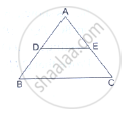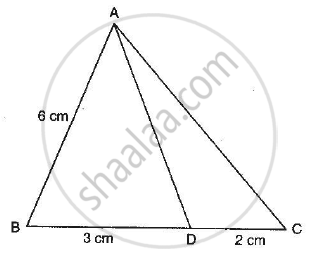Advertisements
Advertisements
प्रश्न
In the given figure, Δ AHK ∼ Δ ABC. If AK = 8 cm, BC = 3.2 cm and HK = 6.4 cm, then find the length of AC.

उत्तर
ΔAHK ∼ ΔABC (The triangles are similar, which means corresponding sides are proportional.)
AK = 8 cm
BC = 3.2 cm
HK = 6.4 cm
We need to find the length of the AC.
Using the proportionality of the corresponding sides of similar triangles, we have:
`(AC)/(AK)` = `(BC)/(HK)`
Substituting the given lengths:
`(AC)/8` = `3.2/6.4`
This simplifies to:
`(AC)/8 = 1/2`
Therefore:
AC = `8×1/2`
AC = 4 cm
Thus, the length of AC in the triangle is 4 cm.
APPEARS IN
संबंधित प्रश्न
D and E are points on the sides AB and AC respectively of a ΔABC. In each of the following cases, determine whether DE║BC or not.
AD = 5.7cm, DB = 9.5cm, AE = 4.8cm and EC = 8cm.

ABCD is a trapezium having AB || DC. Prove that O, the point of intersection of diagonals, divides the two diagonals in the same ratio. Also prove that
There is a staircase as shown in the given figure, connecting points A and B. Measurements of steps are marked in the figure. Find the straight line distance between A and B.

In ∆ABC, ∠A = 60°. Prove that BC2 = AB2 + AC2 − AB . AC.
In the adjoining figure, if AD is the bisector of ∠A, what is AC?

If ∆ABC and ∆DEF are two triangles such that\[\frac{AB}{DE} = \frac{BC}{EF} = \frac{CA}{FD} = \frac{3}{4}\], then write Area (∆ABC) : Area (∆DEF)
In ∆ABC, D and E are points on side AB and AC respectively such that DE || BC and AD : DB = 3 : 1. If EA = 3.3 cm, then AC =
If in ∆ABC and ∆DEF, \[\frac{AB}{DE} = \frac{BC}{FD}\], then ∆ABC ∼ ∆DEF when
A chord of a circle of radius 10 cm subtends a right angle at the centre. The length of the chord (in cm) is
If E is a point on side CA of an equilateral triangle ABC such that BE ⊥ CA, then AB2 + BC2 + CA2 =
